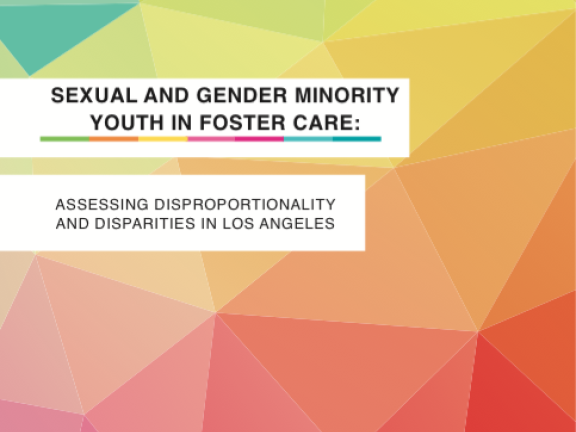Published October, 2014
Sexual & Gender Minority Youth in Los Angeles Foster Care, Bianca D.M. Wilson, Khush Cooper, Angeliki Kastanis, Sheila Nezhad, The Williams Institute (2014)

This report of the Los Angeles Foster Youth Study (LAFYS) represents a first step toward population-based data collection on LGBTQ foster youth. Researchers from 
the Williams Institute and Holarchy Consulting conducted the LAFYS, a telephone interview study with 786 randomly sampled youth ages 12-21 living in foster care in Los Angeles County.
The goals of the LAFYS were:
- to accurately and confidentially assess the proportion of foster youth who identify as LGBTQ,
- to assess whether LGBTQ youth are overrepresented in foster care, and
- to help understand the experiences of these foster youth within the child welfare system.
The survey collected information about a range of demographics, including sexual orientation, gender identity and gender expression. It also assessed youth’s experiences in foster care as they relate to risks to permanency and wellbeing, such as information on placements, homelessness, and schooling.
The survey found that:
- 19% of LA County youth in out-of-home care identify as LGBTQ.
- the majority of LGBTQ youth in the sample were youth of color.
- there are between 1.5 to 2 times as many LGBTQ youth living in foster care as LGBTQ youth estimated to be living outside of foster care.
- LGBTQ youth have a higher average number of foster care placements and are more likely to be living in a group home. They also reported being treated less well by the child welfare system, were more likely to have been hospitalized for emotional reasons at some point in their lifetime, and were more likely to have been homeless at some point in their life.
The report concludes by listing implications of the findings for consideration by policymakers and practitioners.
Copyright Information: CHLP encourages the broad use and sharing of resources. Please credit CHLP when using these materials or their content. and do not alter, adapt or present as your work without prior permission from CHLP.
Legal Disclaimer: CHLP makes an effort to ensure legal information is correct and current, but the law is regularly changing, and the accuracy of the information provided cannot be guaranteed. The legal information in a given resource may not be applicable to all situations and is not—and should not be relied upon—as a substitute for legal advice.